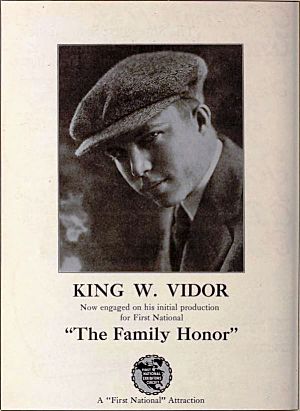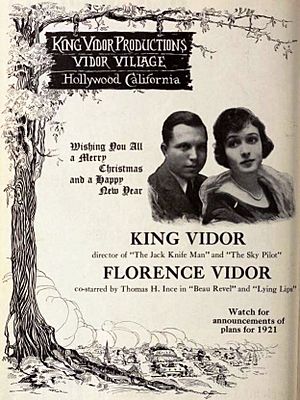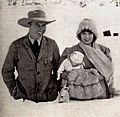King Vidor facts for kids
Quick facts for kids
King Vidor
|
|
|---|---|

Vidor in 1925
|
|
| Born | February 8, 1894 Galveston, Texas, U.S.
|
| Died | November 1, 1982 (aged 88) Paso Robles, California, U.S.
|
| Other names | King W. Vidor |
| Occupation |
|
| Years active | 1913–1980 |
| Spouse(s) |
Florence Arto
(m. 1915; div. 1924)Eleanor Boardman
(m. 1926; div. 1931)Elizabeth Hill
(m. 1932–1978) |
King Wallis Vidor (born February 8, 1894 – died November 1, 1982) was an American film director, producer, and writer. He had a very long career in movies, lasting 67 years. He successfully made films during both the silent movie era and when sound was added to films.
Contents
King Vidor's Early Life and Career Beginnings
King Vidor was born in Galveston, Texas, into a family that had enough money. His father, Charles Shelton Vidor, owned a lumber business. His grandfather, Károly Charles Vidor, came to Galveston in the 1850s after leaving Hungary. King Vidor's mother, Kate Wallis, was related to Davy Crockett's second wife. His first name, King, was given to him in honor of his mother's favorite brother, King Wallis.
When he was six years old, Vidor saw the terrible damage caused by the Galveston Hurricane of 1900. This experience stayed with him. Later, in 1935, he wrote a story about the disaster called "Southern Storm" for Esquire magazine. Years later, in 1939, he even directed the famous cyclone scene for the movie The Wizard of Oz.
Vidor's mother taught him about Christian Science when he was very young. This faith influenced his movies, giving them a mix of practical self-help ideas and spiritual beliefs. He went to grade school at the Peacock Military Academy.
King Vidor's Film Career
As a boy, King Vidor loved taking pictures and developing them himself using a simple Box Brownie camera. When he was sixteen, Vidor left high school and went back to Galveston. There, he worked at a Nickelodeon, which was an early movie theater. He took tickets and operated the film projector.
At 18, Vidor started as an amateur newsreel cameraman, learning how to make documentary films. His very first movie was footage he shot of a local hurricane. He also sold film of a Houston army parade to a news company. His first fictional movie was a short comedy about a car race called In Tow (1913).
In 1918, at age 24, Vidor directed his first Hollywood movie, The Turn in the Road (1919). He made three more films for Brentwood Corporation, all starring the actress Zasu Pitts, whom he had discovered. These films also featured his wife at the time, Florence Arto Vidor, who was a rising star.
Vidor's early films often showed groups of ordinary people working together. Later, his movies focused more on individuals and their personal journeys.
One of his most famous silent films was The Big Parade (1925). His movies from the 1940s and early 1950s are also considered very important. Some of his best works include Northwest Passage (1940), Comrade X (1940), and Duel in the Sun (1946). In his Western films, nature often felt like a strong force that characters had to fight against to survive.
Vidor was known as an "actors' director" because he was great at guiding actors. Many actors he worked with received Academy Award nominations or even won awards. These included Wallace Beery, Robert Donat, Barbara Stanwyck, and Lillian Gish.
Vidor was nominated five times for the Best Director Academy Award. In 1979, he received an Honorary Academy Award for his amazing work as a filmmaker. He also won many other film awards during his career.
He sometimes gave talks about making films at universities in California. In 1972, he published a book called On Film Making, which shared stories from his movie career.
King Vidor's Personal Life
In 1944, King Vidor, who was a Republican, joined a group called the Motion Picture Alliance for the Preservation of American Ideals. This group supported American values and was against communism.
Vidor wrote a book about his own life called A Tree is a Tree in 1953. The title comes from a story early in his career. Vidor wanted to film a movie in real outdoor locations, but it would cost a lot of money. A producer told him, "A rock is a rock. A tree is a tree. Shoot it in Griffith Park!" This meant he should just film in a nearby park to save money.
King Vidor was a Christian Scientist and sometimes wrote for his church's publications.
King Vidor's Marriages
Vidor was married three times:
- Florence Arto (married 1915–1924)
- They had a daughter named Suzanne (1918–2003).
- Eleanor Boardman (married 1926–1931)
- They had two daughters: Antonia (1927–2012) and Belinda (born 1930).
- Elizabeth Hill (married 1932–1978)
King Vidor's Death
King Vidor passed away at his ranch in Paso Robles, California, on November 1, 1982. He was 88 years old and died from a heart problem.
King Vidor's Films
|
|
King Vidor's Academy Awards and Nominations
King Vidor was recognized many times for his work in movies.
| Year | Award | Film | Result |
|---|---|---|---|
| 1927–28 | Best Director | The Crowd | Frank Borzage – 7th Heaven |
| 1929–30 | Hallelujah | Lewis Milestone – All Quiet on the Western Front | |
| 1931–32 | Outstanding Production | The Champ | Irving Thalberg – Grand Hotel |
| Best Director | Frank Borzage – Bad Girl | ||
| 1938 | The Citadel | Frank Capra – You Can't Take It with You | |
| 1956 | War and Peace | George Stevens – Giant | |
| 1979 | Academy Honorary Award | for his amazing work as a movie creator and innovator | |
Awards for Actors in King Vidor's Films
Many actors who worked with King Vidor were nominated for or won Academy Awards.
| Year | Performer | Film | Result | ||||
|---|---|---|---|---|---|---|---|
| Academy Award for Best Actor | |||||||
| 1931–32 | Wallace Beery | The Champ | Won | ||||
| 1938 | Robert Donat | The Citadel | Nominated | ||||
| Academy Award for Best Actress | |||||||
| 1937 | Barbara Stanwyck | Stella Dallas | Nominated | ||||
| 1946 | Jennifer Jones | Duel in the Sun | Nominated | ||||
| Academy Award for Best Supporting Actress | |||||||
| 1937 | Anne Shirley | Stella Dallas | Nominated | ||||
| 1946 | Lillian Gish | Duel in the Sun | Nominated | ||||
Academy Awards for King Vidor's Films
Here are the Academy Awards won or nominated by films directed by King Vidor.
| Year | Film | Academy Award Nominations |
Academy Award wins |
|---|---|---|---|
| 1927–28 | The Crowd |
|
|
| 1929–30 | Hallelujah |
|
|
| 1931–32 | The Champ |
|
|
| 1936 | The Texas Rangers |
|
|
| 1938 | The Citadel |
|
|
| 1940 | Northwest Passage |
|
|
| Comrade X |
|
|
|
| 1946 | Duel in the Sun |
|
|
| 1949 | Beyond the Forest |
|
|
| 1956 | War and Peace |
|
|
Other Awards for King Vidor
In 1964, King Vidor received the Golden Plate Award from the American Academy of Achievement. In 1979, he was given an Honorable Prize at the 11th Moscow International Film Festival for his contributions to cinema. In 2020, over 30 of his films were shown at the 70th Berlin International Film Festival to honor his work.
Images for kids
-
King Vidor and Colleen Moore on location for The Sky Pilot near Truckee, California
-
Hendrik Sartov (cinematographer), King Vidor (director), Irving Thalberg (producer) & Lillian Gish (co-star) on the set of La Bohème
-
Vidor directed the black & white scenes for The Wizard of Oz (1939), including Judy Garland singing Over the Rainbow
See also
 In Spanish: King Vidor para niños
In Spanish: King Vidor para niños









